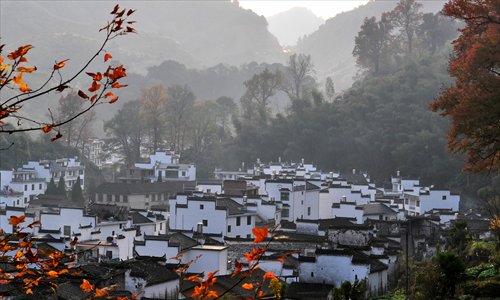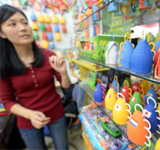| Wonders of Wuyuan | ||||||||||
|
||||||||||
http://english.dbw.cn
2014-12-01 08:43:41
|
||||||||||
 Fed up with the dismal weather that enshrouds Beijing every November? Why not escape to a place where there are clear, blue skies as well as colorful, spectacular scenery? Wuyuan, a county in Jiangxi Province, while already famous for its boundless fields of golden canola flowers in spring, is increasingly becoming renowned for another of its natural beauties: the blush of red maple leaves in autumn. Scenes of cloud and mist Unlike the intense golden red color of the maple leaves that adorn Fragrant Hill in Beijing every October, the maple leaves one encounters in Shicheng village of Wuyuan are of a paler shade, closer to scarlet or claret-red. Smaller in size, these maple leaves are at their most beguiling around at sunrise, seen against the backdrop of the morning mist and the first tender rays of sunlight. The villages at the foot of the mountain are also an indispensable part of the scenery. Shrouded by the mist, the ash-colored contours of those houses create a sense of nostalgia reminiscent of sentiments expressed in ancient Chinese poems. Brought to public's attention by a group of photography enthusiasts in 2009, the maple leaves in Wuyuan, like the canola flowers in the region, have quickly gained a reputation for their unique beauty. These days, those familiar with Wuyuan all sing a common refrain: go in the spring for the canola flowers, and in autumn for the red maple leaves. If you also happen to be a shutterbug, and are hoping to snap a picture at the precise moment that the first radiant rays of light illuminate the crimson leaves, bear in mind that securing an optimal place on the mountains before 5 am for that perfect shot is crucial. After that, the place becomes a heaving mass of photographers with their hulking equipment. Whether you decide to spend the night on the mountains or get up early to secure your spot, the perfect way to cap off your morning of photo-taking is by enjoying a delicious breakfast. Just make sure that you're well-prepared and bring your own food. Apart from a few local snacks like pancakes, most of the food served by the local villagers (who are the only people from which one can procure food in Shicheng) there are a scarcity of options for those in search of a breakfast buffet. Hui-style architecture in Sixiyan It's not just in Shicheng either: The lack of tasty local food is recurring problem in many of Wuyuan's scenic spots. Though the place does not have any shortage of local specialties like tea, chrysanthemum and camphor wood to buy as souvenirs or gifts, satisfying one's stomach seems to be a bit of a challenge, especially for tourists coming from the north of the country. On a more positive note, the scenery in Wuyuan is captivating enough that all but the most finicky of tourists will forget about their hunger as soon as they gaze upon the stunning panorama around them. For those who are going to Wuyuan to see the maple leaves in Shicheng or the terraced canola flowers in Jiangling, picking the right season is crucial (autumn for the maple leaves and spring for the canola flowers). For other popular tourist spots in Wuyuan, this is not so important, although one might be wise to consider going in winter or summer to avoid the inevitable crush of tourists during the two transitional seasons. For resorts such as Sixiyan village, traveling in the off-season is not a bad choice. Located in the north of Wuyuan, the village is home to many ancient Hui-styled buildings dating back to the Ming (1368-1644)and Qing (1644-1911) dynasties. During the low season, aided by the informative explanations delivered by tour guides, one has more time to take in the details of wood and stone carvings which adorn the facades of the buildings, and which are typical features of Hui-styled architecture. Historically under the administrative jurisdiction of Anhui Province, Wuyuan maintains several Hui-styled buildings left by famous Hui merchants (hui shang). Emerging from the Song Dynasty (960-1279) and enjoying its golden era during the late Ming and early Qing periods, these Hui merchants left a great deal of architecture that is of cultural and historical significance. Condensing the essence of the culture of the time, Hui-styled architecture embodies the thinking and philosophy of the times. Sitting north and facing south, they emphasize not only utility in design, but also a meticulous sense of aesthetics. The exquisite engravings on those buildings have a wide range of features, and are also widely acclaimed and studied by both domestic and foreign architectural experts. Most of the old buildings in Sixiyan village are well protected, and some of them still have residents living in them. They are a testament of the country's profound history: The disparity in the construction and furnishings between some of the buildings underline the economic disparities that existed between different families in feudal times, and the partially damaged engravings on the roofs or pillars are a vestige of the Cultural Revolution (1966-76), in which superstition and tradition were mercilessly stamped out as regrettable relics preventing the march of progress. Time to time, one also spots new buildings that copy the exteriors and colors of the ancient architecture. The reasons behind this are complicated, and include the local residents' desire to improve their living conditions while remaining unwilling to compromise with the government. The buildings represent a balance between the interests of the locals, and the desire of the government to continue maintaining the area as a tourist attraction. Other instances of exceptions to the aesthetic harmony of the area can be found in Likeng village, a popular tourist spot with a high concentration of ancient architecture. Many of these old buildings are connected by bridges over canals, creating an even more beautiful tableau that is scarcely seen in other parts of the country today. But while traveling around the village, tourists might feel perturbed by the amount of newly transported building materials blocking their way. Intangible heritage Catching up on local folk customs while traveling around the area is a great addition to one's understanding of local culture. In Wuyuan, there are a number of such local customs that fit the bill. Nuo Drama a kind of dance opera that utilizes ghost masks, is quite popular. Originating in the Western Zhou Dynasty (1046-771 BC), this ancient art was placed on the national intangible cultural heritage list in 2006. Traditionally performed mainly in sacrificial ceremonies to drive out evil spirits over Chinese New Year, Nuo Drama now performed to mark a number of other inaugurations, such as during the opening of a construction site, a company or at wedding and birthday ceremonies. Every Chinese New Year, local Nuo Drama performers will also leave their villages to perform the ancient opera to people in other parts of the country. Nuo Drama is regularly performed in Jiangwan, another town that is steeped with history and ancient architure which lies in the east of Wuyuan. Besides Nuo Drama, other local folk customs such as Tai Ge, a traditional dance which combines painting, opera and acrobatics, is also a national-level intangible cultural heritage. However, to experience such performances, one is required to visit during Chinese New Year period, as this is the time when the most skilled performers gather to revel in this ancient folk tradition.
|
||||||||||
| Author: Source: xinhua Editor: Yang Fan |
||||||||||
 中文简体
中文简体










